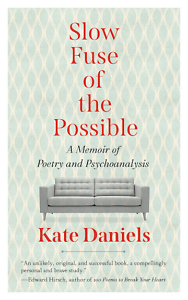Like Walking into a Poem
Standing along the fragile edge
On the opening page of Slow Fuse of the Possible: A Memoir of Poetry and Psychoanalysis, poet Kate Daniels makes a provocative statement about the several years she spent with an analyst. “Sometimes, it was like walking into the intensely compressed words of a poem itself,” she writes. “Eventually it became like walking into a poem as it was actually in the process of being written.”
 Daniels’ analysis, which took place when she was in her mid-40s, was what she calls “classical form”—four sessions a week on a couch with an analyst who sat mostly silent, out of view. Severely depressed and “a veteran of earlier psychotherapies,” Daniels had sought out Ama, who was still in training at the time. At first, Daniels was charmed. Ama was about her age, and Daniels loved her two-syllable name (a pseudonym, though we can assume the original was similar). “It was a dyad, a duet, a couplet, a duo,” she writes. They fell into a routine, “two women alone together, by choice, for many months, and then for several years, in a quiet room.” Out of the silence Daniels heard her own voice, at first “querulous and petulant” and then full of images that “mushroomed up from the murky vacancy” of her mind.
Daniels’ analysis, which took place when she was in her mid-40s, was what she calls “classical form”—four sessions a week on a couch with an analyst who sat mostly silent, out of view. Severely depressed and “a veteran of earlier psychotherapies,” Daniels had sought out Ama, who was still in training at the time. At first, Daniels was charmed. Ama was about her age, and Daniels loved her two-syllable name (a pseudonym, though we can assume the original was similar). “It was a dyad, a duet, a couplet, a duo,” she writes. They fell into a routine, “two women alone together, by choice, for many months, and then for several years, in a quiet room.” Out of the silence Daniels heard her own voice, at first “querulous and petulant” and then full of images that “mushroomed up from the murky vacancy” of her mind.
Over time, Daniels exhibited deep feelings of both eroticism and hostility toward Ama, which she describes in candid detail. “I know that I was a difficult (and very resistant) patient. I was depressed, defensive, terrified, untrusting, and quick to challenge. Appallingly often, I was aggressive and hostile in my interactions with my analyst.” Expecting Ama’s office to resemble a scene from a Woody Allen movie or The Sopranos, she criticized Ama’s décor, including the shabby couch and the presence of an uncovered trash can, which made her feel like trash. At one session, she intentionally shattered a pot she had brought to give Ama. Mostly, she resented Ama’s refusal to read her poetry and her carelessness with words and details.
Now the Edwin Mims Professor of English at Vanderbilt University and author of six poetry collections, Daniels brings her poet’s sensibility to the project of recounting the ebb and flow of her mind’s wanderings, which she had recorded in a journal. Her shifting engagement with 19th-century poet Emily Dickinson is particularly intriguing. As a professor, she had taught Dickinson in the typical way, stressing her solitary life and perseverance. In analysis, the “iconic facts of Dickinson’s life slid away” and she became “an interplay of language and silence: pure poetry.” Epigraphs from Dickinson’s work preface most of the chapters as well as the book itself, explaining the title:
The Possible’s slow fuse is lit
By the Imagination —
 Over time, Daniels became aware that her analysis was not working, a realization she attributes in hindsight to a mismatch and Ama’s lack of experience. Earlier therapy had been “productive and warm,” but “cold” images for Ama emerged in her mind: “a frost-encrusted refrigerator; a frozen human heart stored in a Styrofoam ice chest; a cool air fan; an air conditioner.” In contrast, her time at a writing residency, away from Ama, made her feel better, as did medication that she obtained from another psychiatrist. She eventually ended analysis.
Over time, Daniels became aware that her analysis was not working, a realization she attributes in hindsight to a mismatch and Ama’s lack of experience. Earlier therapy had been “productive and warm,” but “cold” images for Ama emerged in her mind: “a frost-encrusted refrigerator; a frozen human heart stored in a Styrofoam ice chest; a cool air fan; an air conditioner.” In contrast, her time at a writing residency, away from Ama, made her feel better, as did medication that she obtained from another psychiatrist. She eventually ended analysis.
Slow Fuse of the Possible is not always an enjoyable read. That’s not a criticism, since the dark morass of the human psyche is not necessarily an enjoyable place. It is a fascinating book, though — amazing in its candor and its ability to capture the flow of free association, like pinning down an ocean wave. Certainly, it offers a new way to think about poetry. “To write a poem or to enter an analysis is to commit oneself to stand along a psychological edge — fragile as a hair — without retreating from the prospect of Terror it affords. This is where each of us meets our Self face to face,” she writes. As I finished each chapter, I found myself going back to the Dickinson quote at its beginning. This usually offered an “aha” insight, though rarely one I could put words around.
In addition to her work at Vanderbilt, Daniels teaches writing at the Washington-Baltimore Center for Psychoanalysis. She says the book came out of conversations with psychoanalysts and writers interested in the connection between writing process and analysis. Near the end, the book seems aimed at this audience, and I found myself wishing she had said more about being “inside a poem” and perhaps how the experience influenced her writing process.
Daniels said she values the experience of analysis, though would probably not do it again. As for Ama, Daniels is generous toward her. “Despite the unpleasantness of our coupling, neither of us had given up on the other.”

Jane Marcellus’ essays have appeared in the Washington Post, Gettysburg Review, Sycamore Review, Hippocampus, and elsewhere. Best American Essays listed her work as “Notable” in 2018, 2019, and 2020.


